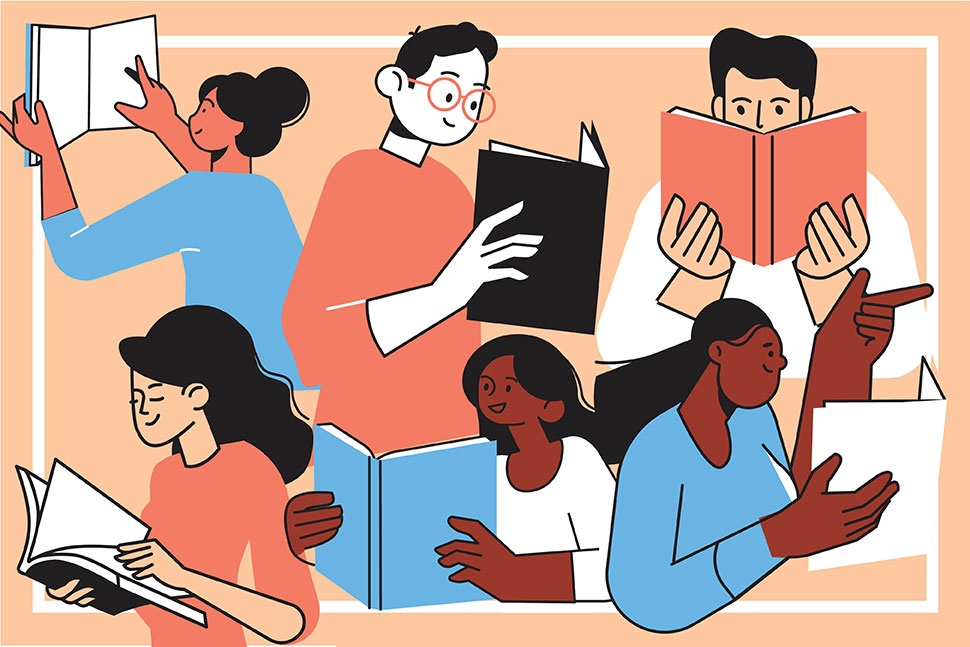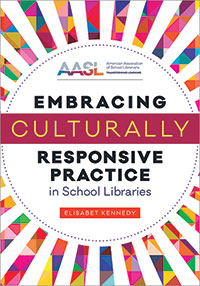Culturally Diverse Collections

School libraries come in many forms. They may be book sanctuaries, hangout spots for learners during noninstructional time, technologically advanced media centers full of activity tubs and work tables, or a combination of these.
Whatever your school’s library is like, the opportunity to bring in culturally responsive principles exists.
If you are a school librarian, time is not always on your side. But with intentional steps, the culturally responsive practices that you decide to implement in your library can be structured into feasible tasks.
Each of the following tasks is grounded in a specific purpose and can be expanded or modified as appropriate. By trying out these strategies, you can engage learners authentically inside and outside the school library.
Expand Readers’ Advisory Networks
Culturally responsive materials may offer learners a look into their own culture or expose them to the cultures of others. These materials include the books on our shelves, the digital subscription services we maintain, the websites that we use to instruct learners, and the magazines that we have in print or digitally.
School librarians are expected to have suggestions for titles and websites in their back pocket, readily at hand when information is needed or recommendations are requested. Luckily, there are culturally responsive resources that can take your suggestions to a new level.

For example, the organization We Need Diverse Books offers a Pinterest board that houses culturally responsive read-alikes for a multitude of grade levels. Not only does this tool expand our readers’ advisory skills and expose us to new titles, but it also offers the reader an explanation for why the second book is suggested.
This tool and those like it can also be used when curricula are being updated. Core texts that may be less culturally responsive can be supplemented by or combined with a more relevant title. This approach is also helpful when supporting a colleague within their classroom. Offering a fellow educator who has taught the same couple of books for years a chance to explore the same theme with newer characters may offer a welcome change.
Other valued resources are found within the book awards circuit. Many book awards and grants highlight culturally inclusive titles. These awards lists can be nationwide, statewide, regional, and even hyperlocal. The lists can provide you with a solid readers’ advisory database as well as suggestions for the school library collection.
Display Themes and Thoughtful Selections
Book displays are a common practice in library work. We use them to highlight our school library’s collection by setting a theme and pulling a few books from the shelves. Depending on the time of year, the grade band, the new hit show, or the latest internet trend, these displays offer school librarians a creative opportunity to draw in learners.
It is easiest to put together a display when we are knowledgeable about the theme, but exploring beyond known territory is worth the effort. Featuring culturally responsive materials in visible ways allows learners to explore serious topics in a safe, controlled environment without feeling like they are fighting a stigma. By exploring coming-of-age topics through the eyes of culturally inclusive characters, learners may feel empowered to discuss and work through potentially sensitive moments with peers or family or even within the school library space.
Buying and displaying books that include characters from racial and ethnic minorities, characters with disabilities, and characters who identify as LGBTQ+ written by authors who share their characters’ identities shows that you are knowledgeable about the population you serve and are an advocate for all learners, including underrepresented voices. Not every book in the school library will represent every population, but including characters that learners can identify with is essential to increasing engagement with the collection.
A strategy that has proven helpful is to keep a yearly calendar that highlights widely recognized awareness observances for different groups, cultures, and causes. This calendar will allow you to access a plethora of events to make displays for.
There are days of the year that are set aside to celebrate differences in ability, like World Braille Day in January, and monthlong celebrations such as National Native American Heritage Month in November that celebrate cultural groups. These calendars are sometimes called diversity calendars, multicultural calendars, or diversity and inclusivity calendars.
A benefit of using a calendar and modifying it as needed is that it acts like a planning document for the school library. Themed displays can be planned well in advance, supplemental materials can be gathered, and, if needed, approval can be granted.
Don’t worry if you feel behind. Whatever our displays may have looked like yesterday, they will continue to evolve daily. We must push ourselves to embrace an environment of constant learning and inclusivity.
Focusing on the Collection
Studying your school’s population data will also give you a perspective on the cultural, socioeconomic, ability, and language demographics of the learners who use your library. If you already have an idea of your school’s population, start exploring what students need and think critically about books that line the shelves. There is never enough time to focus on collection development properly, but taking a microscope to only one section may offer you fewer materials to work with and still have the desired effect.
For example, my learners were increasingly asking for graphic novels written in Spanish. As a result, I analyzed my collection. I saw that the collection was lacking, first in graphic novel options in general, but then more specifically those written in Spanish.
Seeing this as an opportunity to expand school library services, engage a new set of learners, and mold the collection based on learners’ needs, I took action. My bulk orders are processed through Follett Destiny, whose website offers the ability to filter search results by language, age recommendation, and series sets when appropriate.
There weren’t many results, but it gave me a starting point. It also opened my eyes to the other Spanish-language titles available that may be useful as supplemental materials for classrooms, like a Spanish-language graphic novel version of Pride and Prejudice. This type of support through the ordering interface allowed me to fill the gap in the collection based on the needs of the learners.
I also turn to the learners who are more comfortable reading in Spanish for suggestions of stories of all kinds. This type of work can be done by making a passive form available in the school library space or by visiting language classes for insight. I focused on looking for Spanish-language fiction and nonfiction titles, but these strategies can be used for all language needs.
We must push ourselves to embrace an environment of constant learning and inclusivity.
Diversity audits (see this issue’s Solutions) are also helpful when analyzing the collection, even if starting with a small subsection. Certain cataloging software, like Follett Destiny’s Titlewave and Mackin, come equipped with a diversity audit function. The collection analysis capabilities highlight pertinent information about the entire collection, like publication dates, Dewey Decimal Classification system comparisons, incomplete records, number of items, and the age of the collection.
Take this data and narrow the scope. Pick a subsection of the school library’s collection. I recommend starting with a section like the 900s, History and Geography. I focused on the 900s and dug deep into the collection, by the tens. This strategy showed me the different subsections within the 900s section, which also correspond with the history of different parts of the world. The same can be done for the 800s section, Literature. Each of these sections houses materials from different places all over the world, and if your school library collection is anything like mine, many of those subsections will be underrepresented.
For example, I had hundreds of books in 940 History of Europe and 970 History of North America, but only about 30 books in 960 History of Africa and four books in 980 History of South America. Similar trends were found in the 800s section. If the school does not provide cataloging software that has collection analysis capabilities, a shelf read may just do the trick. Auditing the collection through a culturally responsive lens opens the door to students’ voices. If you have volunteers or aides, this approach could be an opportunity to involve them in the collection maintenance process.
An excellent opportunity for learner involvement related to the school library collection is the formation of focus groups or advisory committees. Nurturing a small group of learners who care about their school library is difficult but worthwhile.
Online surveys and other digital tools make it easier to survey learners and understand their relationship with and habits within the school library. Once learners’ school library habits are better understood, relationships can be formed, and agency can begin. A focus group or advisory committee can lend its time to collection analysis projects and diversity audits using resources like Reading Diversity: A Tool for Selecting Diverse Texts from the Southern Poverty Law Center’s Learning for Justice initiative. With this tool, learners and other educators can survey a handful of books, with guided questions that relate to race, ethnicity, gender, class, age, ability, religion, place, immigration status, LGBTQ+ identities, and more. This tool might also be helpful when evaluating texts for stereotypes or misrepresentations. Learning for Justice also offers classroom resources, magazines, professional development, and frameworks for instruction to support social justice work in education.
Small focus groups or advisory committees with dedicated members not only foster a sense of agency between the learners and the school library but also nurture critical thinking and advocacy efforts. The learners who take part in collection development can then go on to make displays, evaluate the space, analyze policy, and be advocates for the school library when called upon. Including learners in assembling essential pieces of the school library puzzle can cultivate a formative school library community.
Access Across Platforms, Spaces, Abilities
Part of managing the collection is ensuring that the materials and resources can be accessed inside and outside the school building, which encourages and advances literacy while nurturing digital citizenship.
Guiding learners in the practice of responsible information gathering when they leave the school building can be facilitated by embracing digital technologies. Using online educational portals, virtual classroom spaces, and social media platforms can increase awareness of and engagement with the digital resources provided by the school library.
Please bear in mind that the digital divide is very real. Some of our learners lack sufficient internet access outside of school. Although this problem affects learners of all races and ethnicities, those from Black and Hispanic households are disproportionately affected. Familiarizing yourself with research about digital access and concerns about equitable access can benefit not only the learners affected but also other educators as they modify their lessons, assignments, and practices.
School libraries seldom have gadgets or internet access points for learners to borrow, but public libraries and local institutions can act as extended shared spaces for learners to study, complete their homework, access necessary resources, and grow. Empowering learners, especially those in typically marginalized populations, by pointing them in the direction of community public services is a vital practice in fostering culturally responsive school library spaces.
Source of Article